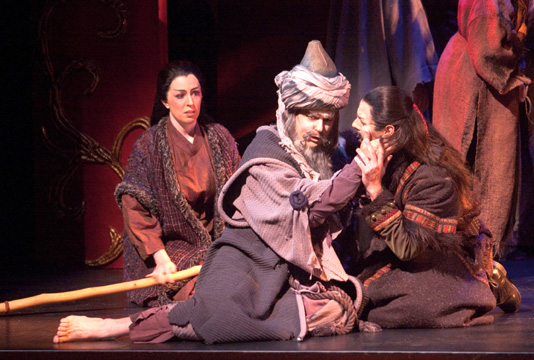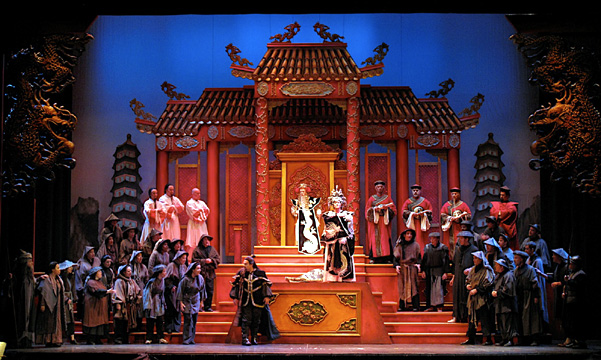Festival Opera kicks out the jambs

A true spectacle. Lavish sets, outlandish costumes, bloodthirsty villagers, and the roar of a bewitched crowd. That was the July 11 premiere of Turandot, a Festival Opera production at Walnut Creek’s Lesher Center for the Arts.
Two years in the making, this production is the largest that Festival Opera has attempted. Director David Cox was not only equal to the task, but managed the huge undertaking on a relative shoestring, with much use of volunteers and by sharing the opulent sets with Alabama’s Birmingham Opera. Bryan Nies, assistant conductor of the Oakland Symphony, returned to conduct—he led Festival Opera’s production of Bizet’s Carmen in 2007.
Giacomo Puccini discovered the bizarre plot in a Persian book of folk tales, and recast the action in a mythical dynasty of China. One wonders if he was following the example of Bizet, whose exotic setting for The Pearl Fishers helps to suspend an audience’s disbelief.
For musical verismo Puccini made much use of the Chinese pentatonic scale, embroidered with Eastern gongs and wooden blocks, wedded to his sophisticated Italian vernacular. This did little to endear him to China, which banned the production for 70 years on the grounds that it caricatured their people. They finally produced it in the Forbidden City in 1998—I guess everybody loves a spectacle.
The curtain rose on set designer Peter Crompton’s golden pagoda roofs and temple gates, washed with the deep blue of night. Massive filigreed dragons framed the stage, while impaled heads framed the action. Villagers crowded in, calling for the executioner to whet his blade. Moonrise was the signal for the beheading of the Princess’ latest hapless suitor, one who was unable to answer her three riddles.
Elaborate steps rose to the high palace gates, referencing a layered society culminating in the divinely descended Princess Turandot.
She suddenly appeared at the gates and the villagers reversed themselves, chanting for clemency. Regal, untouchable, with an ice-sculpture headdress, she gazed out for a long moment, then slashed her hand across to gesture beheading, and the latest prince was led out.
And in that moment Calaf sees her and is overcome. But by what? Could love enter so swiftly? Or is it lust and power that impel our tenor? There are serious weaknesses in the plot and characterizations, but somehow Puccini brews them all up to offer us a mulled wine of terror spiced with riddles. And it works. Sort of.
Turandot is played with frightening believability by the beautiful Canadian lyric soprano, Othalie Graham, with a punishingly high tessitura. Her new suitor, Calaf, is Christopher Jackson, a tenor with a sensuous and covered sound. The one weakness of this production could be that the two are not well matched vocally. But be that as it may, her icy notes keen across his tender arguments for love, a metaphor for their duel.
Calaf’s blind father, Timur, is sung by notable regular Kirk Eichelberger, and his reverberant bass regularly steals the show. Singing the part of Liu, the peasant whose hopeless love for Calaf leads to her downfall, is Rebecca Sjöwall, and her warm soprano and soft penetrating notes brought the house down.
And the topper? Jackson’s heartfelt rendition of Nessun dorma (no-one sleeps). This was the great Pavarotti’s signature song, a song that propelled him to the top of the world’s charts for his deep coloration and astonishing brightness.
Jackson’s voice is less bright, but thick with longing, and from their wild applause, the crowd knew that something special had just happened.
For all its flaws, this is Grand Opera, and absolutely not to be missed.

Two performances remain: Friday, July 17 at 8:00p.m. and Sunday July 19 at 2:00p.m. For tickets see www.festivalopera.com/tickets or call (925) 943-SHOW.
—Adam Broner
This review originally appeared in the Piedmont Post
Photos: Top, (from left) Rebecca Sjowall as Liu, Kirk Eichelberger as Timur, and Christopher Jacskson as Calaf. Bottom, sets designed by Peter Crompton.
